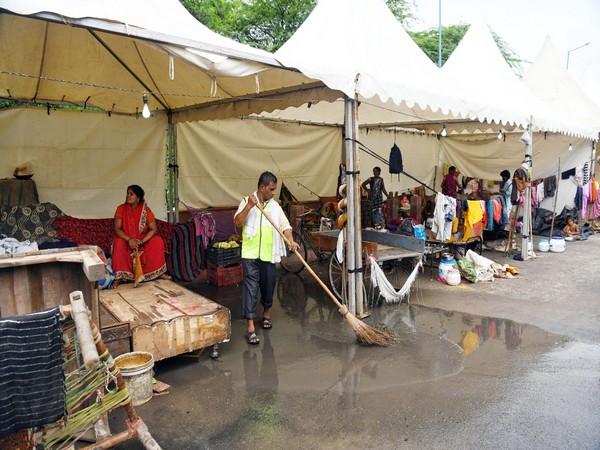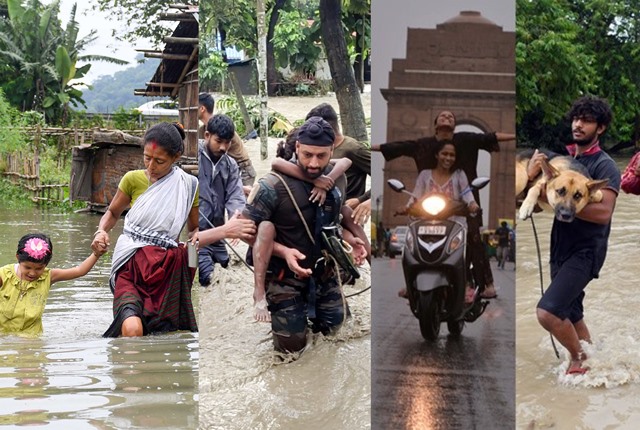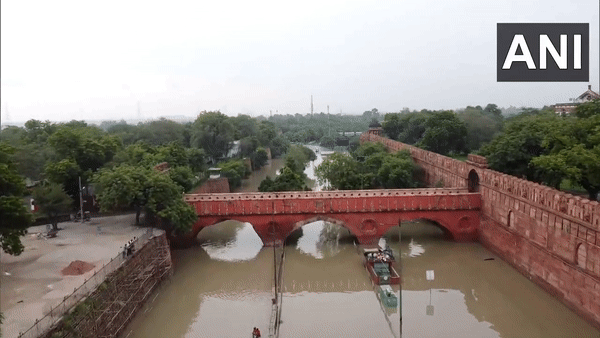Hello, beautiful man I’ll never have on Rue Charlot. Hello, woman smoking
by the Seine and closing her eyes between drags.
We’re all lost, even in Paris,
and if this place won’t take my mood off you,
I guess I’m in love
And in for more rain…
– Alex Dimitrov, Someone in Paris, France, is Thinking of You
Let the rain kiss you, Let the rain beat upon your head with silver liquid drops, Let the rain sing you a lullaby.
– Langston Hughes
Under the undulating flyover, Indian classical dancers, all women, are dancing their epical dance: Kuchipudi, Oddissi, Kathak, Bharat Natyam. Even a gypsy woman is dancing in absolute abandon, her hair flying with the wind in symphony with her colourful skirt. And the rain falls like a cosmic galaxy on a wounded country, soaking it with delight, healing it, helping it to survive with optimism and song, in such bleak, bleak times, when a demonic evil stalks the land.
Not always. The Yamuna floodplains have flooded yet again, as is the annual ritual during monsoon. In East Delhi, the peasants and daily-wagers who work on lease on the lush green land made fertile with the dirty waters of the nullah called Yamuna, ravaged and degraded by urban civilizations since decades, have yet again moved up on the pavements and below the flyover, watched by our women classical dancers.
Like the thousands of migrant workers and their families, emaciated, famished, hungry and thirsty, holding sacks with their bare belongings, who trekked across miles of hot highways under the hard sun of a scorching summer after the sudden lockdown of March 24, 2020, and left to their fate to die on the streets, suddenly, the urban society has discovered these invisible tillers-of-the-land, who have come to showcase their life and times to the citizens of Delhi. So, who are these people yet again, to which country do they belong?
Their humble huts are floating in the waters like democratic monuments of eternal progress. And, like every year, year after year, they have set up another time-tested river-civilisation, on the margins of post-modernity, with swanky cars and SUVs floating by. While the front pages of newspapers celebrate India’s glorious, much-belated journey to the moon! And, that too, after much chanting and prayers, seeking the blessings of miscellaneous Hindu gods.
The displaced citizens of India have set up their homes quickly, resilient residents of earth, as they are, like artists who know their craft. Kids are jumping up and down in the open-to-sky courtyards on a ‘charpai’, women are cooking thick rotis on make-shift chulhas with wood collected from the mini-forest in the neighbourhood, shared with pickle, onion and green chilly, the elderly women are stiching and fixing old clothes, and a young boy is playing a flute in the corner, oblivious of the morning traffic rushing by.
The morning flute has an intrinsic, sublime and soothing sound, soaked with dew drops of the dawn, hiding the night’s unrequited fantasies. It’s a melody which lingers and stays inside my cotton shirt, like a not-so-forgotten, much-familiar, fragrance, flowing with the north wind, as I sing an old Rafi song, riding on my grumbling, vintage, mobike.
Suddenly, old books have yet again started smelling like wood, bark, fallen leaves, lost petals, old sweaters , cotton saris, and wine. Suddenly, books have yet again found their time and space in forgotten forests with mountain-springs and birds chirping at midnight. Suddenly, the pages turn on their own, making a sound of friendship, seeking attention, surrounded by the soft smell of tobacco, as a nocturnal breeze carried by the western disturbances enters the window, like a slow shadow of the past. And life becomes nostalgia yet again, in fast-forward- slow-motion, refusing to go away.
Torrents of rain in the sleepless, summer courtyards, and we don’t need the coolers now. The first mangos, raw and ripe, in the mango orchard next to our home, has enveloped the small-town night with its heady, addictive, seductive aroma, and the songs in the All India Radio Urdu Service, remind us of lost loves and long, lonely journeys, submerged in the longings and desires of the sensuality of the earth, smelling of rain, skin and humidity.
Under the ledge on the terrace, protected from the diagonal and crafty rain, I tell the kids of the mohalla spontaneous ghost stories without head or tail, mostly concocted at the spur of the moment. The kids hold their ‘susu’ out of a joyful, artificial fear, thirsty for more ghost stories. And the water flows through the terraces of childhood like a song of the road: Pather Panchali.
It would be a rainy day tomorrow. If it is exam day, oh, what infinite joy! Rainy days are perhaps the most inspiring days of childhood when all the story books come out, from Enid Blyton’s Malory Towers and Famous Five, to Chandamama, Phantom and Champak. This is the time to enter the mysterious, unexplored terrain of imagination and dream. This is the time to experiment with truth.
Rabindranath Tagore wrote a precious memory of the torrential rain of Bengal in his sprawling home called ‘Jorashonko’ in North Calcutta, with its entrance marked by an amphi-theatre. This is after Kal-Boishaki of March-April, when a certain theatre in the skies is enacted with magical melodrama – thunder, lightening, fierce winds, the blue sky changing into vermillion, orange, red, before the darkness of these romantic nights surround the soul and the heart with deep desires. In Kal-Boishaki, rain never ever arrives, but, there is something primordial and elemental about it, like the poems of Walt Whitman and Jorge Luis Borges.
So it is raining in Tagore’s family home and the kids are overjoyed. Today, therefore, Mastermoshai – the strict tuition teacher – will not arrive – how can he, in this fierce rain? But, then, tragedy strikes – because, there he is, in his dhoti and kurta, riding his ramshackle bicycle, holding his ancient black umbrella, determined as always!
In a quiet and solitary railway station somewhere near Bongai Gaon in Assam, a tea-vendor from Bihar is writing a letter under the flickering light of a lantern. In the midst of a meadow and vast, empty land, the railway tracks shine with metallic glory as rain strikes the earth, filling the railway station with a sweet, shadowy, ghostly mist. This is the place where one should spend a few nights in the rain and write a short-story. This is the place where one should fix up a secret rendezvous. This is the place where one should come every monsoon, with a bottle of Old Monk, a notebook and a fountain pen.
So why is he writing a letter past-midnight, surrounded by this eternal, nocturnal solitude? “A train will arrive soon,” he says. “It will travel through Bengal. And, then, to my homeland – Bihar. It will take my letter to my mother, father, wife and children. I miss them!”
Read More: http://13.232.95.176/









